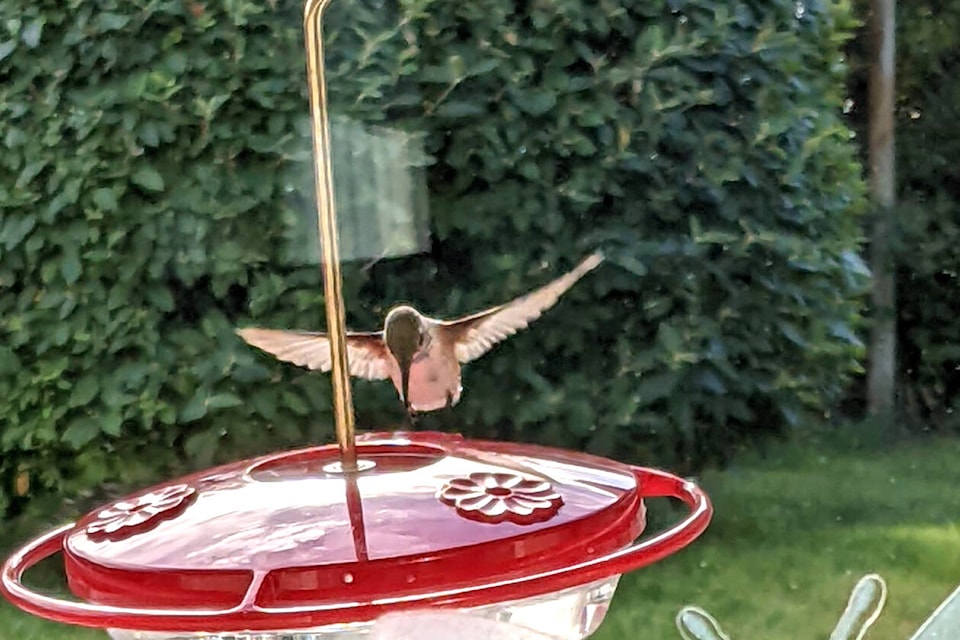Karen Siemens
North Okanagan Naturalists Club
Soon we will be able to enjoy the spectacular courting rituals of the male hummingbirds as they try to impress a female with their aerial acrobatics and impressive dives.
The rufous, black chinned and calliope hummingbirds will be back for hopefully a very successful breeding season. We may see them by mid April and enjoy them until mid to late August. The males usually leave around the end of June. The females are busy raising the juveniles so we can enjoy them through July into August before the babies have matured and stored enough energy to begin their journey south along with the females.
You may see an Anna’s hummingbird that has made its way here post breeding from the coastal areas. We see them from time to time but they are not a common sight.
If you are unable to maintain a clean feeder and change food as often as required from April to August then please rely on the plants in your garden or hanging baskets to supply nectar.
Hummingbird feeder hints
• Clean feeders
Clean with hot water and dish soap. Rinse off all residue of soap.
Feeder should be completely dismantled and feeding ports taken apart.
Use a bottle brush for inverted feeders and pipe cleaners for the small holes.
Every time you refill your feeder take it apart and rinse with hot water.
Twice a week use the brush and pipe cleaners and soap to ensure it’s clean.
Do Not use your dishwasher as it leaves a residue in the feeder.
Black mould is a death sentence to hummingbirds. If there is any sign of it soak your feeder in soapy hot water for one hour then scrub with your brushes to remove any traces of mould.
• Feeders
Glass feeders are the best. If you buy plastic make sure that it is Food Grade Plastic or UV Stabilized. This ensures there is no chemical leakage into the food they eat. Cheap plastic disintegrates and will contaminate the food. If you can find a feeder without yellow on the ports do so as yellow is an attractant for insects ie: wasps.
Whether you use inverted feeders or the basin style make sure that the feeder can be completely dismantled for cleaning.
• Food
The best food for hummingbird feeders is made by you! Think of your thumb as the one part white sugar and your four fingers as four parts water. Add sugar to boiling water to dissolve or you may add boiling water from a kettle to sugar stir till it completely dissolves. Cool to room temperature before filling feeder. You can store this in the fridge for seven days but warm to room temperature before filling feeder.
Never use brown sugar, honey or sugar substitutes as these contain components that will harm the birds.
Do not use red dye (the red on the feeder is all that is needed to attract them). Do not add scent.
• Changing food
When temperature is 27 degrees or above change every day.
When temperature is 26 degrees or below change every three days.
Reasons: 1) Heat increases the growth of mould, 2) Every time a hummingbird bill is inserted into the feeder microbes are introduced that feed on the sugar. After three days there is no sugar left for the birds.
• Plants
Hummingbirds eat, and also feed their young, insects. These insects feed off plants. Ensure the plants or seeds you buy or are not treated with pesticides because the pesticide is found not only in the nectar the hummingbirds ingest but also the insects they gather for their babies and themselves.
Many people are spending more time in their gardens and if you are xeriscaping you can go to Okanagan Xeriscape and in their filter check hummingbird and it will give you a list of plants hummingbird friendly. A few that are popular are bee balm, columbine, foxglove, honeysuckle and Russian sage. Native plants are an excellent choice even if it is only one or two different kinds.
If you do not have a garden then hanging baskets are very attractive to hummingbirds with flowers like salvia, fuchsia, snapdragons, verbena, nasturtium and the every popular petunia.
Keep your hanging baskets out of reach of predators.
For more information on Hummingbirds in B.C. go to rpbo.org, website for Rocky Point Bird Observatory in Victoria.
READ MORE: Blossoms and berries of Okanagan hillsides
READ MORE: Enderby drive-in movie theatre preparing for May opening
@VernonNews
newsroom@vernonmorningstar.com
Like us on Facebook and follow us on Twitter
